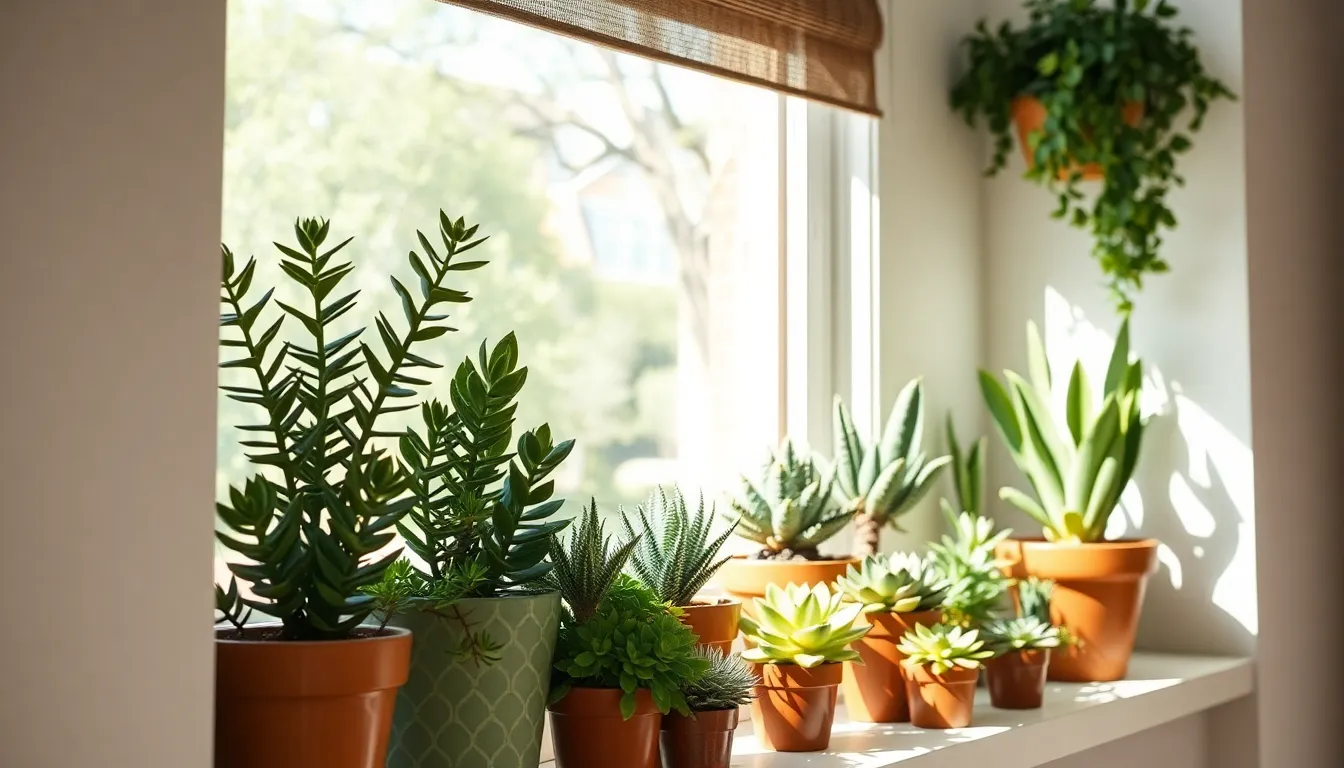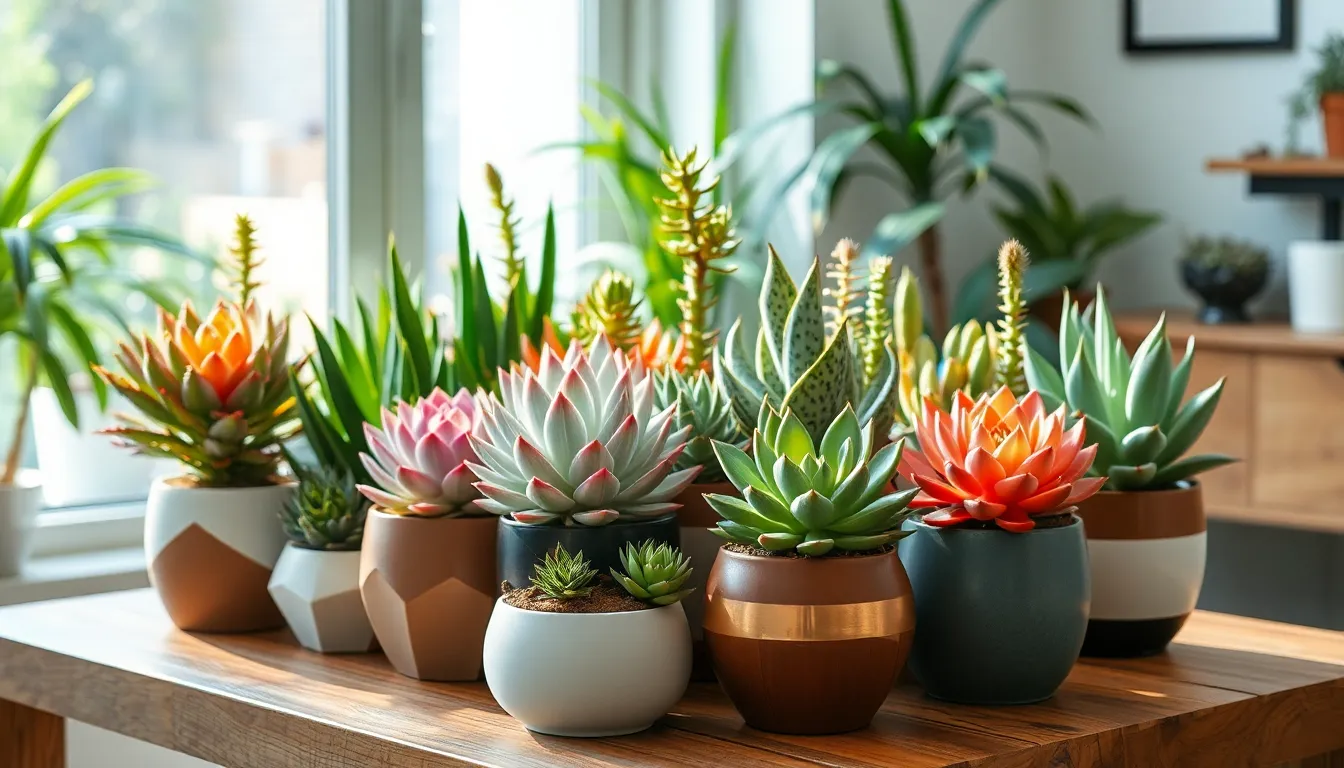Imagine a plant that thrives on neglect, looks fabulous in any setting, and requires minimal care—meet succulents, the low-maintenance darlings of the plant world. These quirky little green gems come in all shapes and sizes, making them the perfect addition to any home or office. Whether you’re a seasoned plant parent or just starting out, succulents are here to save the day (and your sanity).
Plant Succulents
Succulents are unique plants known for their thick, fleshy tissues. These adaptations allow them to store water, making them ideal for various climates.
What Are Succulents?
Succulents belong to a diverse group of plants characterized by their water-storing capabilities. They come in many shapes, sizes, and colors. Each species has evolved to thrive in arid conditions, capturing moisture from the air and soil. These attributes make succulents popular in homes and gardens. Easy care routines further contribute to their appeal, allowing even novice gardeners to successfully cultivate them.
Types of Succulent Plants
Numerous types of succulents exist, appealing to various aesthetic preferences.
- Aloe Vera: Renowned for its medicinal properties, Aloe Vera displays thick leaves and vibrant green hues.
- Echeveria: Echeveria features rosette-shaped leaves and bright colors, making it a favorite for decorative arrangements.
- Jade Plant: This plant symbolizes good luck, showcasing oval-shaped, glossy leaves that keep their structure over time.
- Sedum: Sedum varieties exhibit a low-growing habit and diverse leaf shapes, well-suited for ground cover.
Each type brings unique traits, enhancing the beauty of any space while requiring minimal attention.
Growing Plant Succulents

Growing plant succulents requires understanding key aspects such as soil type and light exposure. Attention to these factors ensures vibrant growth and longevity.
Choosing the Right Soil
Selecting well-draining soil represents a crucial step in succulent care. Specialized cactus mix often works best, allowing excess water to escape quickly. Organic materials like perlite or sand improve drainage, preventing root rot. Some growers combine regular potting soil with these amendments for optimal results. Regular monitoring of soil moisture levels helps maintain healthy plants. Always choose pots with drainage holes to facilitate proper water management.
Ideal Light Conditions
Positioning succulents in the right light is essential for their growth. Most varieties thrive in bright, indirect sunlight for several hours daily. Direct sun exposure can cause leaf burn; therefore, placing them near windows with filtered light works well. Rotating plants helps ensure even light distribution, promoting balanced growth. Observing changes in leaf color or shape can indicate light needs. Keeping track of seasonal variations in daylight can also enhance succulent health.
Caring for Plant Succulents
Caring for plant succulents involves specific techniques to ensure their health and longevity. Understanding their needs makes maintenance straightforward.
Watering Techniques
Watering techniques play a crucial role in succulent care. Succulents require infrequent watering, especially in winter. Water deeply when the soil is dry, allowing excess moisture to drain. Overwatering causes root rot, so checking the soil’s dryness before watering is essential. Using the soak-and-dry method is effective; this involves soaking the soil and letting it dry completely between waterings. In humid conditions, reducing watering frequency further prevents fungal issues. Observing the plant’s leaves can also provide clues; shriveled leaves indicate drought, while mushy leaves signal overwatering.
Fertilization Tips
Fertilization tips enhance succulent growth. During the active growing season, typically spring and summer, applying a diluted, balanced fertilizer every four to six weeks promotes flourishing. Opt for a cactus fertilizer for best results. Avoid fertilizing during the dormant season to prevent nutrient buildup. Customizing fertilizer strength according to the plant’s growth stage ensures optimal health. Additionally, choosing organic options can improve soil quality over time. Observing the succulent’s growth response helps determine if adjustments in fertilization are necessary.
Common Issues with Plant Succulents

Succulents can encounter various challenges. Addressing these issues promptly ensures the health of the plants.
Pest Management
Pests pose a threat to succulent health. Mealybugs, aphids, and spider mites commonly infest these plants. Regular inspections help detect infestations early. If pests appear, it’s crucial to act swiftly. Cleaning the leaves gently with a damp cloth removes visible pests. Applying neem oil or insecticidal soap effectively targets these nuisances without harming the plants. Encouraging beneficial insects, like ladybugs, also aids in pest control by naturally reducing pest populations.
Identifying and Treating Diseases
Diseases can afflict succulents, with root rot being a primary concern. Overwatering contributes significantly to this issue, leading to mushy roots. Plants exhibiting yellowing leaves or stunted growth may indicate problems. To address these signs, inspecting roots and removing any that show decay is essential. Treatment involves repotting in fresh, well-draining soil. Fungal infections, often appearing as spots or blights, require fungicides for treatment. Ensuring proper air circulation and adequate sunlight helps prevent future occurrences of diseases.

